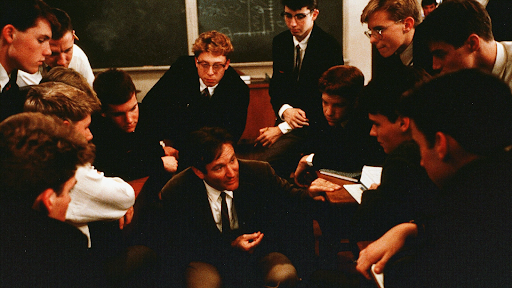Sophia Noya | Contributing Writer
Dead Poets Society celebrated its 35th anniversary this month.
Peter Weir’s film follows a New England boarding school in the late 1950’s, where a group of students, inspired by their English teacher, fight against rigid tradition and strive to make their lives their own.
The Best Picture nominee remains popular- the most recent stage adaptation debuted in 2021, and it was parodied by Saturday Night Live in 2016. It was played in my own high school English class, causing a cataclysmic flood of tears that the janitors are probably still mopping up to this day.
The film is a love letter to the humanities. It confronts themes of nonconformity and individualism in the authoritative Welton Academy, where its pillars of tradition, discipline, honor and excellence reign supreme over nonsensical ideas like hopes and dreams.
Robin Williams stars as the bohemian Mr. Keating, and he received a Best Actor nomination for the role. Robert Sean Leonard is Neil Perry, outgoing leader of the poets, and Ethan Hawke stars as the shy Todd Anderson, who breaks out of his shell during the course of the movie.
Despite winning Best Original Screenplay, Dead Poets Society has weak spots. There is a simplicity to the story that can be seen as superficial, even pretentious–I found it interesting that no real poetry analysis ever happens (the idea is vehemently rejected, actually), and yet we are made to believe that Keating has a deep understanding of the topic, and should be listened to.
Dead Poets Society can be cheesy and sentimental, but it’s a romanticism I felt worked strongly in its favor. In a movie so dedicated to love of life and humanity, such dramatics should be expected, and even wanted. It never becomes distasteful or excessive, and instead it struck me as incredibly heartwarming (see “cataclysmic flood of tears”).
The poets themselves work spectacularly as a group. There’s a real sense of camaraderie and friendship that you can’t help but be touched by and want to be a part of.
Cinematographer John Seale creates a cozy world for the poets with a grainy glow and warm colors. The oranges, yellows and browns soften the world of the poets, creating a perfect bookish environment for them to bloom in. When the unthinkable happens in the third act, we are plunged into a world of icy blues, a brutal wake-up call and a destruction of the poet’s sanctuary.
The shots in the movie tend to focus on one character or object at a time, which prevents details from passing by unnoticed and allows for a deeper connection with characters while they’re on the screen.
Camera movement is used conservatively, which makes moments like Todd’s barbaric yawp scene all the more impactful. The camera spins around Todd and Keating as he creates an impromptu poem, the disorienting motion representing an instrumental moment for Todd as he gains confidence and comes into his own.
Dead Poets Society is inspiring and emotional. I could not help but be charmed by its beauty and starry-eyed idealism. It leaves audiences enthused and wanting to take action, artistically or otherwise. Its message and passion will continue to stand the test of time.
9/10


Great article and honest critique